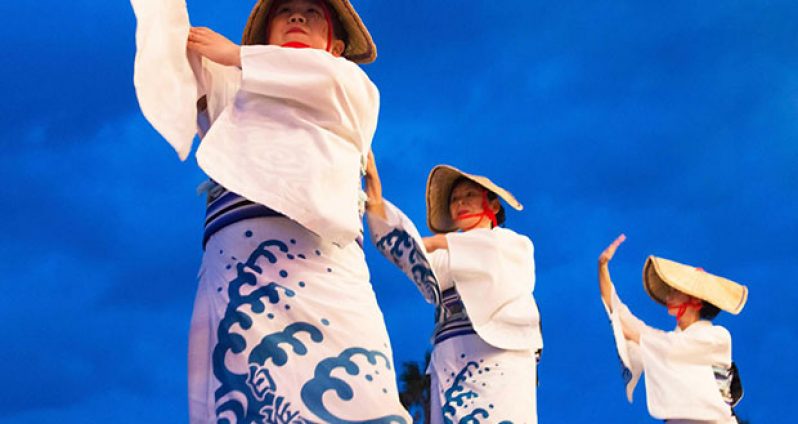– The Ama are Japan’s last population of female shell divers. But with their way of life and culture increasingly under threat, could this be the end of an age-old tradition?

(BBC) Kimiyo Hayashi sat warming herself by the fire pit inside a salt-licked, weatherboard hut on Japan’s Ago Bay. The air outside was sticky and thick, yet she huddled beside the flames, chattering quietly with her niece Tomomi Nakanishi.
“I have been in the sea my whole life, and no matter how hot it gets, I still feel the chill in my bones,” Hayashi said, looking out across the pincer-shaped promontory. “I love the tradition of warming up afterwards.”
Among Japan’s last female free divers, Hayashi and Nakanishi stubbornly cling to the old ways of life. Their floor was covered with ashen planks, a charred kettle was on the boil and the roof was black with soot. Face masks and frayed rubber wet suits, the womens’ only concession to modernity, dripped metronomically from a rail.
This timeless scene might seem far removed from contemporary Japan, but the region of Ise-Shima in Mie Prefecture is awash with such maritime tradition. And none is more fantastical than the stories about the Ama, the enigmatic women of the sea who were first recorded in the oldest Japanese anthology of poetry, the Man’yoshu, in the 8th Century. It is a legend, some say, that dates back 3,000 years.

An expressive 61-year-old with sharp eyes, Hayashi began to tell her story. Every morning, in the predawn light, she would watch dozens of near-silent Ama process through the darkness of the dockyard with lit bamboo torches. Some would be bare-breasted, wearing just a fundoshi (loincloth) and tenugi (bandana). She would wave to her grandmother and mother, both veteran Ama, always wondering what drew them out beyond the swell of the waves. When she was 16, she was finally asked to join them.
Forty-five years later, her ritual at sea is still the same. Once on the boat, dressed head-to-toe in a traditional white cloth outfit, she plunges headfirst into the deep, sometimes as far as 1km away from shore. With all the grace and guile of a mermaid, her legs and toes pointed and powerful, she vanishes, sometimes to 10m deep, disappearing to mine the seabed for shellfish and seaweed.
Considering the lack of technical equipment – no snorkel, no aqualung – it’s hard to imagine the hardships the Ama face in the freezing seas and dangerous currents. Regular accidents have become a way of life, shark encounters aren’t unheard of and there’s always that biting cold. Over the years, Hayashi said, she has lost many good friends.
The key, she explained, is not how long the Ama can hold their breath for, but how fast they can hunt. Beneath the waves, sometimes for a gut-wrenching two minutes at a time, the Ama need to be decisive and efficient. In her heyday, she said, she would return to shore with a haul of wooden buckets overflowing with abalone, sea urchin, snails, lobster and octopus. While the original Ama sought lustrous pearl oysters, a good shellfish season could reap as much as 27 million yen. It was a given that a daughter would one day follow her mother out to sea.
But nowadays, the harbour buzz has vanished. While the Ama who still embrace this age-old tradition continue to find freedom and fraternity on the open waves, they do so in ever-dwindling numbers.
Hayashi and Nakanishi are coming to terms with the fact that they may well be the last of their generation. Their daughters are not interested, and the average age in their diving community has peaked at 65. Incredibly, Ise-Shima’s oldest free diver is in her late 80s.
The question is: how can these original hunter-gatherers survive in a modernised society like Japan? Ama numbers have reduced so drastically that there are now fewer than 2,000 practicing — 8,000 fewer than in their post-WWII heyday. And that figure keeps falling. In Ago Bay, the epicentre of the fabled Ama legend, there are just 25 left, and other coastal towns are faring just as badly.
It is an emotional seesaw to have their world taken away, Hayashi said, a pang of regret in her voice. “We need more women to become Ama so our tradition does not die. But where will they come from? It makes me so very sad.”
The problem is few young Japanese women see the benefits. Under pressure from falling seafood stocks, the trade isn’t as lucrative as it once was, and jobs in Osaka, Nagoya and Tokyo are far more appealing. On a bad day, a day’s free diving can bring back as little as 2,000 yen — scant reward for such life-threatening risk.
The Ama have also become victims of commercial fishing, which continues to drastically reduce the available bounty. Highly prized abalone fetches as much as 10,000 yen per kg at market, but in an attempt to encourage stock regeneration and safeguard sustainable shellfish levels, government regulations continue to tighten each year, often preventing the Ama from foraging for in-demand shellfish.
Still, the Ama’s saviour may be their history. In the past year, four traditional ama-goya, the rustic huts where divers relax and socialise, have opened to tourists, with veterans like Hayashi cooking hand-dived shellfish for guests. Once exceedingly rare to see inside, these rudimentary beach shacks offer a window into a clandestine, old-fashioned way of life.
For now, though, Hayashi says this new initiative has simply strengthened her resolve.
“I love my job and I wouldn’t change it for the world,” she concluded, with an optimistic twinkle. “As long as I’m healthy and happy, I have at least another 20 years left in my lungs and legs. So I’ll keep diving. It’s what I was born to do.”





.jpg)








